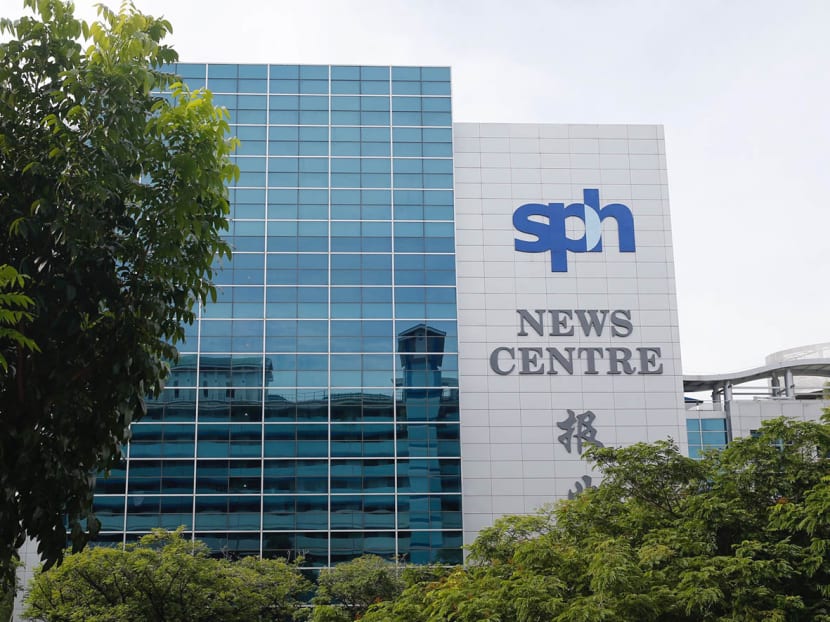SPH Media files police report over inflated circulation numbers after internal probe finds potential offences
SINGAPORE — SPH Media Group said it has filed a police report after an internal probe found that potential offences may have been committed during efforts to artificially inflate circulation numbers of publications such as The Straits Times and The Business Times.

A file photograph of SPH News Centre.
- SPH Media Group said it has filed a police report after an internal probe found potential offences may have been committed to artificially inflate circulation numbers of titles such as The Straits Times and The Business Times
- In a report made public on June 21, its own committee detailed the operation of the schemes, such as how bulk copies were shredded and sold to a waste collector
- The report redacted various names and references to specific possible offences
- The committee's report repeatedly stated that there was “no available evidence” to suggest that board members of Singapore Press Holding (SPH) or most of its senior management were in the know of the alleged wrongdoing
- The committee's chair reportedly said the police report included just the details of the committee's report and had not been made against individual or entities
SINGAPORE — SPH Media Group said it has filed a police report after an internal probe found that potential offences may have been committed during efforts to artificially inflate circulation numbers of publications such as The Straits Times and The Business Times.
In filing the police report on Wednesday (June 21), the company was acting on one of the recommendations of a 13-page report by the company’s audit and risk committee commissioned after details of the saga emerged in January.
Mr Max Loh, who chairs the committee, reportedly said in an internal briefing to SPH reporters that the police report involved the findings of the probe, but had not been made against specific individuals or entities.
“We’ve laid out what the issues or the findings are. And I think we really have to leave it to the relevant authorities, which, in this case, are the police, to figure out how they’re going to proceed and maybe, if at all, they want to proceed,” he was quoted by The Straits Times as saying.
Mr Loh also did not reveal how many people were interviewed for the internal report, only saying that it included more than 10 people.
The committee's report also detailed the operation of the schemes to inflate the circulation numbers, such as how bulk copies were shredded and sold to a waste collector. In another instance, only seven digital subscriptions to The Straits Times and The Business Times were accessed in a barter scheme that was supposed to involve 15,000 subscriptions.
Details of the saga emerged in January this year when SPH Media Trust, which is part of SPH Media Group, said some staff had left the organisation and others had been “taken to task” after the daily circulation numbers were found to have been inflated by between 85,000 and 95,000.
The committee's report repeatedly stated that there was “no available evidence” to suggest that board members of Singapore Press Holdings (SPH) or most of its senior management knew of the alleged wrongdoing, which was kept among circulation department staff members.
SPH was an Singapore Exchange mainboard-listed company that was delisted in May 2022, around the time that SPH Media was spun off as a separate entity.
In a statement on Wednesday accompanying the report, SPH Media said: “The findings also concluded that the accounting impact is not deemed to be material to the financial statements of SPH Media Group for the financial year ended Aug 31, 2022 taken as a whole.”
The company said that it will fully cooperate with the authorities in their investigation.
It added that it will also act on the committee’s other recommendations on benchmark circulation reporting and further enhancing its risk management practices.
In response to TODAY's queries, a Ministry of Communications and Information spokesperson said: "We are studying the findings and working with SPH Media Holdings to understand the details. We will share our views in due course."
The following are the key findings and recommendations made by the committee:
KEY FINDINGS
The probe, conducted by the audit and risk committee with the assistance of law firm Allen & Gledhill and consultancy firm Deloitte, found that the circulation numbers were inflated by an average of about 82,600 daily, based on the month of August 2021.
These came from bulk copies via a fund set up by the company called the Newspaper in Education (NIE) Fund that were reported but not distributed (49,000 copies).
It also resulted from a barter deal and another deal, known as the Y deal, where an unnamed company paid a nominal sum for the right to print 5,000 copies of The Straits Times.
These 5,000 daily copies of the paper continued to be included in circulation figures even after the Y deal ended in February 2021.
There were also copies of publications meant to be distributed but were instead sent to SPH's warehouse or printing centre, to be disposed of later, referred to employees as “Avatar” copies.
NEWSPAPER IN EDUCATION FUND
The report said the NIE fund was set up internally as early as 2000 to pay for distribution of newspaper samples to students, needy families, halfway houses and charities.
“The NIE Fund was used to pay for NIE bulk copies used to shore up the circulation numbers in (SPH's) annual reports, cushion the fall in print circulation numbers and to meet KPI (key performance indicator) targets in respect of circulation numbers for the circulation division,” the report said.
The probe found that the total amount charged to the NIE Fund for bulk copies and recorded as circulation revenue during the review period of September 2020 to March 2022 was about S$748,000.
The fund was closed in May 2022 following the discovery of the overstatement of numbers in March that year.
The report stated that the practice of printing and distributing copies to third parties “appears to be an acceptable practice” in the newspaper industry. However, copies cannot be counted if they are returned, unsold or undelivered.
“The persons who were involved in the overstatement of circulation numbers (and in particular, had knowledge that copies that were not delivered were included in the reported circulation numbers) were from the circulation division,” the report found.
“There has been no evidence sighted to suggest that the (SPH) board or its senior management (save for [redacted]) were involved in this.” The report redacted any detail of the senior management allegedly involved.
It said the redactions had been made given SPH's confidentiality obligations and "for good order in respect of the identities of the concerned parties, specific details of the transactions as well as possible offences involved".
UNDELIVERED, DESTROYED 'AVATAR' COPIES
The probe also discovered an arrangement where copies of publications paid for by the NIE Fund as well as those meant to be distributed to schools were instead sent back to SPH facilities for storage before they were subsequently disposed of.
“The general understanding amongst the interviewees who were aware of the term 'Avatar' was that it meant 'throw away',” said the report, referring to the undistributed and disposed copies.
“The NIE Bulk Copies would be stacked and stored in the print centre and on the instructions of the Circulation Division [redacted]: Discarded, delivered to a client at a later date or delivered to halfway houses and charities in case of audit checks,” it said.
It added that copies for schools were delivered to an SPH warehouse and some of these copies were eventually disposed of.
The report, however, stated that when exactly the practice first started, how many copies were delivered or otherwise, and how many were disposed of and pulped “could not be conclusively determined” due to limited records.
“Knowledge of 'Avatar' and the practice of disposing print copies was limited to employees within the Circulation Division. This included: [redacted],” the report read.
“There is no evidence to suggest that the Listco Board [redacted] were aware of the practice of disposing print copies or of the term 'Avatar'”.
X BARTER DEAL
Under the barter deal, company X provided e-paper digital subscriptions to SPH in exchange for 15,000 The Straits Times and The Business Times digital subscriptions. No real cash changed hands as the amounts to be paid for the subscriptions offset against each other, the report explained.
The probe observed that there was “negligible activation of digital access codes” for The Straits Times and The Business Times digital copies, indicating that there were limited efforts to distribute the codes under the deal.
Only seven digital subscriptions for The Straits Times and The Business Times had been accessed as of July, 2022, some 18 months after the scheme was put in place.
An unnamed individual was aware of the activation rates under the barter deal.
“From [redacted] perspective, the arrangement was for a legitimate purpose and did not have any impact on (SPH's) financials given that it was a “contra” deal," the report said.
"From [redacted] perspective, The Straits Times and Business Times digital subscriptions could be counted in circulation numbers since they had been paid for.”
The report stated that barter deals between media organisations are not improper.
However, the barter deal “could potentially have evolved into a questionable arrangement entered into for the sole purpose of inflating circulation numbers and revenue, without a genuine intention to execute the arrangement”.
Y DEAL
Company Y paid SPH monthly royalty fees and was granted an exclusive limited licence to print and distribute 5,000 copies of a publication related to The Straits Times from 2013 to March 31, 2022.
“These 5,000 daily copies were reported as part of SPH’s circulation numbers, even after printing under the Y Deal stopped in February 2021 [redacted],” read the report.
Overall, the best-estimate impact of the practices listed in the report on the financial year ended Aug 31, 2021 were:
- An understatement of about S$110,000 of profits in relation to the NIE Fund practice
- Overstatement of revenue and expense of about S$830,000 in the financials statements of SPH Media Group arising from the X Barter Deal, though there was no impact on profit and loss
- In response to queries from TODAY, an SPH spokesperson said on Wednesday that “the S$830,000 overstatement of revenue and expense was below the accounting materiality thresholds as set by the external auditor for SPH Media Group’s FY22 financial statements”. “Materiality” refers to the concept that information should be disclosed to shareholders if it is deemed to have a material impact on a company's share price
RECOMMENDATIONS
Besides recommending the filing of a police report, which the company has accepted and acted upon, the committee set out the following recommendations for SPH Media Group following the probe:
- The method to calculate readership numbers should be benchmarked to internationally accepted standards, audited by an external third party, clearly recorded in guidelines available to all employees and reviewed regularly
- Evaluate its risk culture and enhance its risk management practices
- Continually improve internal controls and processes











